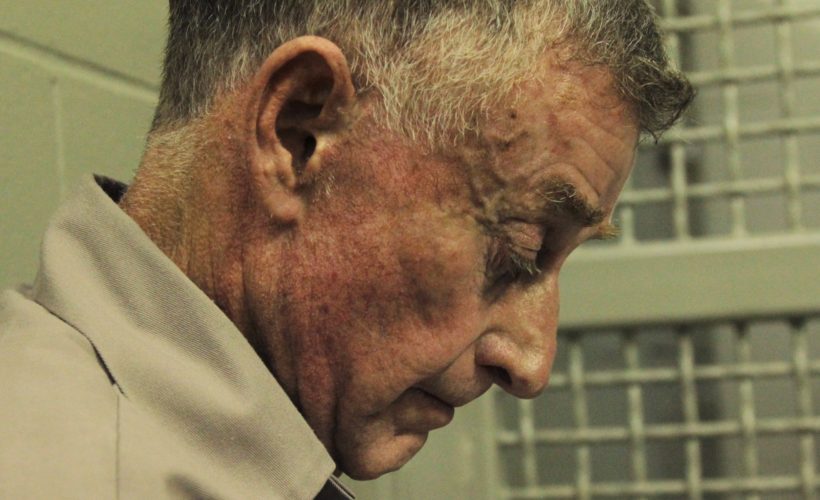As true-crime obsessives already know, last Friday Netflix dropped The Staircase, a docu-series chronicling the 2001 death of Kathleen Peterson and the subsequent murder trial of her husband, Michael. While the project followed a long and circuitous route to the streaming giant—it originally premiered in the US on the Sundance Channel in 2005, then received a two-hour follow-up in 2013, all before Netflix packaged it together and added some new footage—it immediately became a word-of-mouth sensation.
If you’ve binge-watched all 628 minutes, you might be tempted to think that the big question is: Did Michael Peterson kill his wife, or did Kathleen Peterson fall down the stairs? But whenever there’s fervent interest in a murder case, there are often alternative theories—and one very popular hypothesis that you didn’t see in Jean-Xavier de Lestrade’s series posits that there was a third party involved in Kathleen’s death: an owl.
Preposterous? It depends on who you ask.
The Raptor Motion
“The first time I heard about the Owl Theory I said to myself, ‘That’s totally stupid!'” says de Lestrade, who has spent the past 16 years following Michael Peterson’s life both in and outside of prison. “But later, Larry Pollard explained to me in a very effective way what he thought could have happened.”
“Larry,” also known as T. Lawrence Pollard, is a lawyer and former Peterson neighbor, and the primary architect of the Owl Theory. In 2009, Pollard filed a motion requesting that Peterson’s conviction be set aside and all charges dismissed or that he be granted a new trial based on the discovery of “new and compelling evidence” that the real culprit in Mrs. Peterson’s death was a raptor, or bird of prey. Included in his 40-point motion, Pollard stated:
- The “Owl Theory” was advanced to the Defendant’s lawyers and the Prosecution at the conclusion of the trial, namely, that Mrs. Peterson
may have been the victim of an attack by a wild bird outside her
house, an attack which caused puncture wounds to her elbows, injuries
on her face and around her eyes, and lacerations to her scalp. The
theory was dismissed at the time on the basis that owls do not attack
human beings and that the theory lacked credibility.
Among the physical evidence Pollard believed backed his claim was “the presence of blood droplets on the brick walkway and the slate landing outside the home” as well as “the existence of feathers attached to Mrs. Peterson’s hair and found by the medical examiner clutched in her left hand with fresh blood.”
In a Netflix bonus feature (see below), Peterson’s attorney David Rudolf makes clear that he believed there was enough evidence to warrant further investigation into whether an owl could’ve done it. “The only real difference, if you will, between our theory at trial and the Owl Theory is the initial infliction of the wounds,” he says.
Testing the Theory
According to Rudolf, the first time he was presented with the theory “was a day or two before the closing, [so] I couldn’t do anything with it.” Had the case been retried, Rudolf says he absolutely would have delved further into its plausibility.
“I consulted with Dr. Carla Dove, the chief ornithologist from the Smithsonian Institution in DC, who agreed to do DNA testing on the feathers,” Rudolf says. Larry Pollard also consulted others, including a neurosurgeon, a professor of veterinary medicine, and Kate P. Davis, executive director of Raptors of the Rockies. (“All three agreed that the wounds on Kathleen’s scalp were consistent with an owl attack,” Rudolf says. All three also provided Pollard with affidavits.)
In Davis’ mind, there’s no question that a raptor was involved. Within just a few minutes of getting a call from Sophie Brunet, editor of The Staircase—who became romantically involved with Peterson during the course of production—Davis conducted a simple experiment. She grabbed a metal salad bowl from her kitchen, covered it with and eighth of an inch of clay, went out to where her own barred owl, Graham, lived, then “picked her up over my head and dropped her on that salad bowl.” She took pictures of the resulting talon marks and sent them to Sophie, who confirmed that they matched Kathleen’s injuries.
When Davis, who has had plenty of personal experience with talon marks on her own body, saw the photos of Kathleen’s injuries, she agreed that they were a match. “I bet my bottom dollar that Kathleen, after the partying and all that, went outside to move some Christmas decorations, the owl hit her in the back of the head, she pulled it off with her hands—[which is how she] got the feathers and poke holes in the side of her face—and dropped it, and that’s why there’s blood outside,” Davis says.
But Davis also maintains that the owl wasn’t the direct cause of death. “She was compromised to begin with, she’s walking up these steep stairs, she’s feeling woozy,” she says of Kathleen Peterson. “She walked up to that 15th stair and she fell backwards.”
Yet Daniel George, a now-retired crime scene technician with the Durham City Police Department who was the first technician on the scene in 2001, doesn’t believe that there was any fall at all—partly because of where the blood was and where the body was. “There was nothing up on the steps themselves,” says George, who recently recounted the experience for An American Murder Mystery: The Staircase, Investigation Discovery’s own special on the Peterson trial. “There’s 19 steps, but no blood any further than five feet up the steps.”
“The amount of blood is really troubling, yes, but how do you explain the type of cuts and lacerations she [had]?” asks de Lestrade. “I don’t know what happened the night Kathleen Peterson died, but I have hard time believing that’s a murder. It is very difficult to explain Kathleen Peterson’s injuries if it is a murder. That’s why, today, I believe the Owl Theory may be the best theory to explain what happened to Kathleen.”
Not So Fast
Though owls have been known to swoop and injure people (earlier this year, there were at least three incidents in Atlanta), hearing of the Peterson case was the first time the idea of a “killer” owl occurred to ornithologist Dove. “It’s not something I would even think about,” she says. “But then somebody showed me a video of an owl attacking this big man. I have no idea one way or the other. I’m not saying I’ve ever heard of it happening—I certainly haven’t. I don’t really know.”
Though Dove consulted with both Peterson’s legal team and the filmmakers of The Staircase, she never had a chance to examine the actual evidence in the case—only photos. And that’s not enough. “When we do the identification work, we do it from fragments of feathers,” Dove says. “We need the fluffy, downy part, which is the fuzzy part at the base.”
The pictures she saw of the feather samples, though, were inconclusive, and couldn’t even point her to a particular taxonomic order of birds, let alone a narrower group or family. “We offered to go down there and go through the evidence to see if we could find more feather fragments,” she says, “but it never materialized.”
As for whether there could have been an owl present, George admits that while investigating the staircase itself, they did find “one item in particular that was maybe a sixteenth of an inch long—it was a curved shape and it looked almost like a mini-talon. We didn’t know what it was.”
Yet the item, which was shipped off to the State Bureau of Investigation (SBI) to be tested, didn’t have any blood on it. “It could have been a piece of a fingernail, it could have been a dog’s toenail, it could have been anything,” George says. “It could have been a piece of wood that was on the steps.”
While many owl theorists have pointed to the fact that the injuries to Kathleen’s head were deep but did not leave her with any deeper skull or brain damage—which would be expected with the blunt force trauma Michael was accused of inflicting on his wife—George says they were still “down to the skull … it certainly didn’t look like anything an owl could have done. It almost looked like it was cut. But the medical examiner determined that those lacerations were caused by a brutal beating of blunt force trauma to the skull.”
Still, Dove and her team saw enough reasonable evidence in the photo to agree to examine the evidence more thoroughly. “We’re professionals and we’ll examine anything that’s reasonable,” she says. (Except maybe the time they received a request to examine some angel feathers; “that was a little bit far-fetched for me,” she admits.)
In early March 2017—less than a week after Michael Peterson entered an Alford plea to involuntary manslaughter—North Carolina’s WRAL.com reported that Rudolf had filed a motion to obtain the feather fragments from evidence so that they could be sent on to Dove for further testing. But the money dried up. “Once the case was concluded,” he says, “there was no funding to test the feathers.”
Given all the uncertainty, the biggest question surrounding The Staircase might actually be: In more than 10 hours, why did the series not mention such an insane-sounding, but still plausible, theory? De Lestrade’s answer is simple: “I decided to keep it out of the film because it was never presented in court. I wanted to stick to Michael Peterson’s judicial journey. I just wanted to present how the legal system will treat the case.”
Could there be another feather left in his documentary cap? Hoo knows.
More Great WIRED Stories
- PHOTO ESSAY: Spot the hidden images in these psychedelic landscapes
- These physicists watched a clock tick for 14 years straight
- Apple’s plans to bring artificial intelligence to your phone
- It’s time to get excited about the future of PCs. (Yes, PCs.)
- 4Chan is turning 15—and remains the internet’s teenager
- Looking for more? Sign up for our daily newsletter and never miss our latest and greatest stories
Source:WIRED











